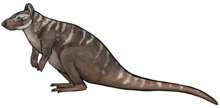Ekaltadeta is an extinct genus of marsupials related to the modern musky rat-kangaroos.[2][3][4] Ekaltadeta was present in what is today the Riversleigh formations in Northern Queensland from the Late Oligocene to the Miocene, and the genus includes three species.[5][6] The genus is hypothesized to have been either exclusively carnivorous, or omnivorous with a fondness for meat, based on the chewing teeth found in fossils.[6] This conclusion is based mainly on the size and shape of a large buzz-saw-shaped cheek-tooth, the adult third premolar, which is common to all Ekaltadeta.[7]
| Ekaltadeta Temporal range:
| |
|---|---|

| |
| Restoration of Ekaltadeta ima | |
| Scientific classification | |
| Domain: | Eukaryota |
| Kingdom: | Animalia |
| Phylum: | Chordata |
| Class: | Mammalia |
| Infraclass: | Marsupialia |
| Order: | Diprotodontia |
| Family: | Hypsiprymnodontidae |
| Genus: | †Ekaltadeta Mike Archer & Flannery, 1985[1] |
| Species | |
| |
Fossils of the animals include two near complete skulls, and numerous upper and lower jaws.
Taxonomy
editThe description of a new species and genus was published by Mike Archer and Tim Flannery in 1985. The type species is Ekaltadeta ima. It was originally put within the family of Potoroidae,[8] but like the musky rat-kangaroo, the genus was moved to the family Hypsiprymnodontidae.[2][4][9] The diagnosis of the genus was revised in a 1996 study by Stephen Wroe of propleopine taxa, after new fossil specimens allowed for comparison with the type material and showcased new characteristics.[3] A largely complete skull of E. ima was described by Wroe in 1998 , prompting another reinvestigation of the propleonine clade which the author had suggested contained paraphyletic and polyphyletic species.[4] E. wellingtonensis has been tentatively placed as Proleopus wellingtonensis in more recent revisions of propleopine taxonomy.[3]
The name Ekaltadeta is derived from two words in an indigenous language associated with the McDonnell Ranges, combining the words for powerful, ekalta, and eta to describe the "powerful tooth". The specific epithet ima means "condemned to die" in the language of the same people.[1] The specific epithet jamiemulvaneyi refers to an honour given to J. Mulvaney as a supporter of the Riversleigh Society.[3]
Distribution
editA member of the exclusively Australian clade Hypsiprymnodontidae, all three species of Ekaltadeta are known exclusively from the Riversleigh World Heritage Area in Queensland.[4] The specimens used in the description of E. jamiemulvaneyi were obtained at two sites in this area, the "Encore" and "Cleft of Ages" sites. Both of these sites are dated to the end of the Middle or the beginning of the late Miocene.[3]
See also
editReferences
edit- ^ a b Archer, M.; Flannery, T. (1985). "Revision of the Extinct Gigantic Rat Kangaroos (Potoroidae: Marsupialia), with Description of a New Miocene Genus and Species and a New Pleistocene Species of Propleopus". Journal of Paleontology. 59 (6): 1331–1349. ISSN 0022-3360. JSTOR 1304948.
- ^ a b "QMF12423 Ekaltadeta ima". learning.qm.qld.gov.au. Retrieved 2019-07-19.
- ^ a b c d e Wroe, S. (1996). "An Investigation of Phylogeny in the Giant Extinct Rat Kangaroo Ekaltadeta (Propleopinae, Potoroidae, Marsupialia)". Journal of Paleontology. 70 (4): 681–690. doi:10.1017/S0022336000023635. ISSN 0022-3360. JSTOR 1306529.
- ^ a b c d Wroe, Stephen; Brammall, Jenni; Cooke, Bernard N. (July 1998). "The skull of Ekaltadeta ima (Marsupialia, Hypsiprymnodontidae?): An analysis of some marsupial cranial features and a re-investigation of propleopine phylogeny, with notes on the inference of carnivory in mammals". Journal of Paleontology. 72 (4): 738–751. doi:10.1017/S0022336000040439. ISSN 0022-3360.
- ^ "Fossilworks: Ekaltadeta". fossilworks.org. Retrieved 17 December 2021.
- ^ a b "Killer Kangaroo". www.wakaleo.net. Archived from the original on 2017-08-22. Retrieved 2017-08-22.
- ^ "Mammals - Fossil Mammals - The Killer Rat-Kangaroo's Tooth". 2008-09-19. Archived from the original on 2008-09-19. Retrieved 2017-08-22.
{{cite web}}: CS1 maint: bot: original URL status unknown (link) - ^ "Potoroidae". 2007-06-11. Archived from the original on 2007-06-11. Retrieved 2017-08-23.
{{cite web}}: CS1 maint: bot: original URL status unknown (link) - ^ Wroe, S.; Archer, M. (July 1995). "Extraordinary diphyodonty-related change in dental function for a tooth of the extinct marsupial Ekaltadeta ima (Propleopinae, Hypsiprymnodontidae)". Archives of Oral Biology. 40 (7): 597–603. doi:10.1016/0003-9969(95)00010-M. PMID 7575230.